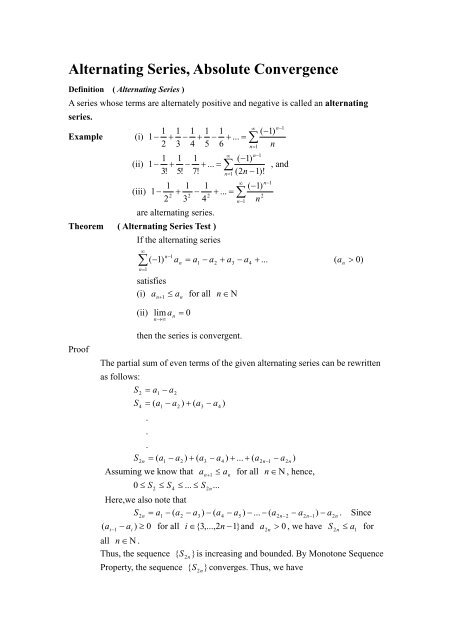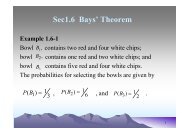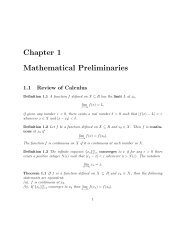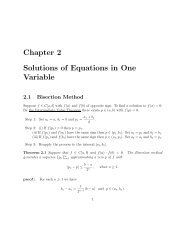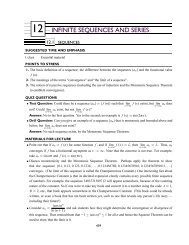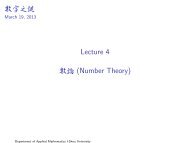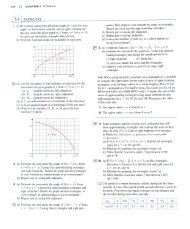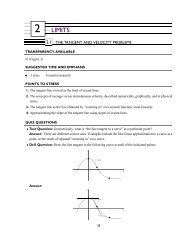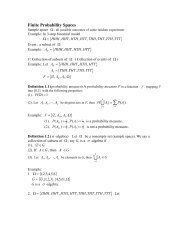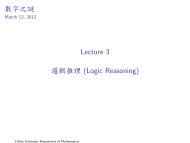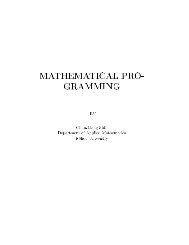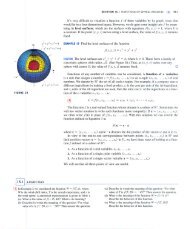Alternating Series, Absolute Convergence
Alternating Series, Absolute Convergence
Alternating Series, Absolute Convergence
- No tags were found...
Create successful ePaper yourself
Turn your PDF publications into a flip-book with our unique Google optimized e-Paper software.
<strong>Alternating</strong> <strong>Series</strong>, <strong>Absolute</strong> <strong>Convergence</strong>Definition ( <strong>Alternating</strong> <strong>Series</strong> )A series whose terms are alternately positive and negative is called an alternatingseries.1 1 1 1 1Example (i) ∑ ∞ 1−+ − + − + ... =2 3 4 5 6 n=1 1 1(ii) ∑ ∞ 1−+ − + ... =3! 5! 7! n=1(iii) 1−221+231−24are alternating series.Theorem ( <strong>Alternating</strong> <strong>Series</strong> Test )If the alternating series∑ ∞n=1( −1)n−1satisfies(i) a ≤1+ ... =1( −1)nn−1n−1( −1), and(2n−1)!∑ ∞n−1( −1)2nn−1a = a − a + a − a + ...( > 0)n1for alln+1 a nn ∈ Ν(ii) lim a = 0n→∞n234a nProofthen the series is convergent.The partial sum of even terms of the given alternating series can be rewrittenas follows:SS2= a1− a24= ( a1− a2) + ( a3− a4...S2n= ( a1− a2) + ( a3− a4) + ... + ( a2n−1− a2n)Assuming we know that an+1 ≤ anfor all n ∈ Ν , hence,≤ S ≤ S ≤ ... ≤ S ...02 42nHere,we also note thata − ( a − a ) − ( a − a ) − ... − ( a − a − a)S2 n=1 2 3 4 52n−2 2n−1)2ni) 0 for all ∈{ 3,...,2n−1a2 n> 0 S2 n≤ a1. Since( a1− a ≥ i } and , we have fori−all n ∈ Ν .Thus, the sequenceProperty, the sequence{ S 2n}is increasing and bounded. By Monotone Sequence{ S 2n}converges. Thus, we have
lim = b .S2 nn→∞Now, we compute the limit of the odd sumlim S2n+ 1= lim(S2 n+ a2n + 1)n→∞n→∞= lim S2n+ lim a2n+1n→∞n→∞= b + 0 = b .Since both the odd and even partial sums converge to b, we haveand the series is convergent.lim S nn→∞= bExample(i)∑ ∞k = 1The alternating harmonic series( −1)kk −1= 1−12+13−14+15( −1)− ... +nn−1+ ...satisfies(a) a+1< a because 1/(n+1) < 1/n for all n ∈ Ν ,nn(b) lim a lim (1/n) = 0.n→∞n=n →∞Thus the series is convergent by <strong>Alternating</strong> <strong>Series</strong> Test.(ii) The series ∑ ∞ (( −1)=lim an→∞nn 1n 1= lim = limn→∞2n−1n→∞12 −nnn /(2n−1))is an alternating series but1= ≠ 0 .2By Test for Divergence, the series is divergent.Now, we trun our attention to the topic on absolute convergence.Given any series ∑ ∞ a=∑ ∞n=1a = a1+ a2nn 1n, we can consider the corresponding series+ L + a +LnWhose terms are just the absolute values of the terms of the originalseries.Definition (absolutely convergent )
∞A series ∑ a iis absolutely convergent if the seriesi = 1∑ ∞i=1a=a+ a+ L +i 1 2a i+ Lis convergent.∞One immediately realizes that if ∑i = 1a iis a positive-termseries,then absolute convergence is the same as convergence.TheoremIf∞∞∑ a iis absolutely convergent, theni =∑1 i = 1a iis convergent.ProofLetb +n= anan. Since - an≤ an≤ an, we have0 an+ an≤ 2 anIf≤ or 0 ≤ bn≤ 2 an.∞∞∑ a nis absolutely convergent, thenn =∑1 n = 1convergent, it following immediately that ∑ =∞∑∞( b n− a n)n = 1is convergent. Sinceconverges and the proof is complete.bn− an 1nb n= ana nisis convergent.∞, ∑ an = 1nExample(i) The following alternating series is absolutely convergent:1 1 1n−111- + − + L + ( −1)+ L.3 3 332 3 4nIf we take the solute value of each term, we get+ 1 1 1 1 11 + + + L + +L3 3 3 32 3 4 5 n3Which is a convergent p-series.Hence thealternating series is absolutely convergent.(ii) The following alternating harmonic series∞∑n=1( −1)1 1 1 1 1 1n−1= 1−+ − + − + L + ( −1)+Ln 2 3 4 5 6nn−11is convergent but not absolutel convergent. It is because the alter-
nating series satisfiesa 1 1n= < a nn + n=+ 1for all n ∈ Ν and lim a lim1n= = 0 .1n→∞n→∞nBy Alternationg Serirs Test we conclude that the alternatingHarmonic series converges. To examine the series for absoluteconvergence, we consider∑ ∞n=1( −1)n−1 1 1 1 1= 1++ + L + + L.n 2 3 nThs is a harmonic series and hence, a divergent series.∞n−1Thus, ∑ ( −1)(1/ n)is not absolutely convergent.n = 1From the above examples, we know that absolute convergenceimplies convergence but the converse is not true in general. Thus,we have the following definition.DefinitionExampleSolutionA series∞∑ ann = 1convergent butis conditionally convergent if∞∑ an = 1nis divergent.∞∑n =Determine whether the following series is convergent ordivergent:∑ ∞n=1cos n cos 2 cos3 cos n= cos1++ + L + + L22 22n2 3 nThe above series has both positive and negative terms but it is notan alternating series, because, for example, the first term ispositive, the next three terms are negative, and the following threeare positive again(the signs chnge irregularly).However, we canapply the Comparison Test to the series of absolute values∞∑cos n=∞∑cos n.22n=1 n n=1 n1a nisSince cos n ≤ 1 for all n ∈ Ν , we havecos n 12 ≤2 .n n∞2∞2Here, ∑ (1/ n ) is a p-series and p =2>1, son =∑ (1/ n )1n = 1
∞2is convergent. Therefore,∑ ( cos n / n )n = 1∞2Comparison Test. Thus,∑ ((cosn) / n )n = 1convergent and hence convergent.is convergent by theis absolutely


